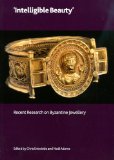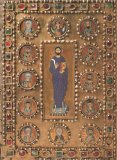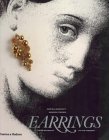


- A pair of Byzantine gold, garnet, pearl, and sapphire earrings, c. 5th-7th century
- Gold earring (Walters 57.1729) with amethysts and enamel, 6th century; “Annular earring with three pendants of plaited chains to each of which is attached a croix patee of hollow gold, the front ornamented with repousse featherings and a central cell holding green vitreous paste; below each cross is suspended an amethyst drop. One cross and one amethyst may be restorations. Hoop earrings with suspended gemstones were worn by women throughout the Byzantine Empire. This unusually fine example has woven 'loop-in-loop' chains linked to small gold crosses, indicating that it was made for a Christian woman.”
- Gold earrings with granulation (Walters VO.129 (57.606, 57.607)), 6th century; “The outer edge of the hollow hoops are lined with granules. A convex shield, dotted in the center, is situated at one end of the hoop; a rigid ring ornament is attached to the bottom. The hoop and granules are completely worn through on one side exposing their interiors.”
- A pair of gold earrings with pearls (57.575 and Walters 57.576), 6th century
- Granulated and filigree gold earring (Walters 57.1571 ) with a crescent shape, 57.1571
- Basket-shaped earrings, c. 6th-7th century
- Pair of crescent-shaped earrings with confronted peacocks (Dumbarton Oaks BZ.1952.13.1-2), 6th-7th century
- Crescent peacock-and-cross earrings (VMFA 66.15.7.1-2), 6th or early 7th century; “Earrings consist of a wire loop for the ear and an openwork crescent with a cross flanked by two confronted peacocks. The pair represents a highly sophisticated interpretation of a popular type of Byzantine earring. They are unique in their use of beaded wire, which accents both the lunar shape and the symmetry of the figural design. The sinuous shape of the peacocks and the curved lines delineating their plumage enliven the composition and complement the crescent form.”
- Gold earrings with pearls and sapphires (Met 17.190.145 and Met 17.190.146), 6th-7th century
- Gold earrings with pearls (Met 17.190.1665 and Met 17.190.1666), 6th-7th century
- A pair of Byzantine gold, glass and pearl earrings (Christie's Sale 7207, Lot 140), late 6th-7th century; “Each composed of a circular gold box, with beaded border, decorated on the front with a rosette, the centre set with a circular pale blue glass cabochon, secured with claws, framed by eight hemispherical petals inlaid with green glass, the reverse decorated with an incised six petalled flower, three solid gold loops below, suspending three composite pendants, each with a glass inlay in a crenelated rhomboid setting above pear-shaped gold beads, cylindrical glass beads and pearls, held in place by a gold wire terminating in a hook, a solid loop with beaded border on top edge for attachment of ear hooks”
- Crescent-shaped earrings, c. 500-700
- Gold earring (V&A M.42-1963), 500-700
- Gold earring (V&A 805-1893), 500-700; “Lunate earring with confronted peacocks and a cross pattee; gold with openwork decoration”
- Pair of earrings (Walters VO.66 (57.560, 57.561)), c. 600; “These dramatic, colorful earrings were most likely made in Constantinople, perhaps as an imperial gift to a Visigothic ruler of medieval Spain, where the earrings were found. The Visigoths, a migratory group that ultimately settled in Spain, had by the 6th century established trade and diplomatic contacts with the Byzantine court, whose jewelry they much admired.”
- Gold earrings (V&A M.6&A-1970), c. 600-700; “During the late Roman era the motif of two peacocks flanking a well or vase (a so-called kantharos) occurred in Christian contexts. The emblem remained popular as a Christian motif in the Byzantine era. The pierced-work technique used to create the design is called opus interrasile, a method of forming patterns by making openings in flat metal surfaces. This technique highlights the play of light and shadow, and was one of the more innovative jewelry-making methods used in Late Antique and Early Byzantine styles.”
- Pair of gold earrings (Cleveland 1947.176.a and Cleveland 1947.176.b with pearls, glass, and emeralds, Byzantium, 7th century
- Crescent earring (Dumbarton Oaks BZ.1994.3.1), 1st half of the 10th century
- Crescent-shaped earrings (British Museum M&ME AF.338), gold with enamel panels depicting birds, 10th century
- Earring (Walters 57.1587), 10th century
- Pair of gold earrings from a Middle Byzantine jewelry hoard (Museum of Byzantine Culture BKo 262/1), 10th-14th century; “They each consist of a cast gold band with granulated decoration and a triple row of pearls along the lower side. Each pearl is fixed on a tiny gold rod with spherical ending. A badly preserved single row of pearls adorned the band's interior. Painted representations of this common type of Middle Byzantine earring illustrate the way that these were worn: either around the ear and lobe without piercing it, or horizontally over the upper part of the auricle.”
- Crescent-shaped earring (Cleveland 1946.493) in gold with enamel, 11th century
- Russian crescent-shaped silver-gilt earrings with cloisonné rosettes, 12th century
- A pair of Kievan Rus' or Byzantine crescent-shaped earrings with rosettes in cloisonné enamel and gold (Met 17.190.2051 and Met 17.190.2052), 12th century
